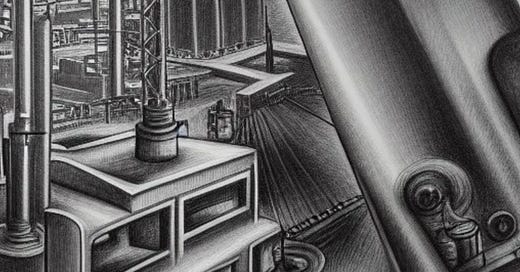FIRST: A Note on "Industrial Policy”…
Stephen S. Cohen & J. Bradford DeLong
September, 2022
The not-quite-surprise passage of the CHIPS Act and the surprise passage of the IRA have brought the idea that the United States should consciously pursue “industrial policy” back to the front burner of politics, and of political economy.
In some ways, however, “industrial policy” is a poisonous term in the discourse of U.S. politics. In the 1980s Democratic economic-policy stalwart Charles Schultze engaged in a full-throated campaign against the idea that the U.S. could run a successful “industrial policy”—“picking winners” in the rhetorical dismissive. Follower nations like Japan attempting to catch up to the U.S. that had succeeded in insulating economic bureaucracies from interest-group rent-seeking might be able to, he argued. But the United States would, to the extent that it embarked on industrial policy, further entrench dissipative rent-seeking interests. Allowing “industrial policy” into the rhetorical room would provide them with yet another set of plausible excuses that the legislators they influence could use for channeling resources in directions that had neither a valid social-welfare nor a valid economic-growth rationale for government protection and assistance.
So let us not call it “industrial policy”. Let us call it “pragmatism” instead. For it is a fact that, from Hamilton through Eisenhower and a bit longer, the American government’s attitude toward the use of public power and public funds for economic development was highly, highly pragmatic—and successful.
Looking back at the economic history of the United States, there is a pattern by which again and again the U.S. economy has been redesigned. The shifts of the economy toward new growth directions have sometimes been the emergent outcomes of innumerable individual actions guided by local price signals. But at other times, and perhaps at more times, they have not. New directions have, instead, been the results of purposeful decisions, taken by government backed by powerful and often broad political forces, guided by their vision of how the economy ought to change. And once the public sector and its allies have launched a new economic space, it has then been expanded and transformed in unimaginable ways by entrepreneurial activity and energy surging into those new directions.
Yes, there was lots of entrepreneurship. Yes, there was an Invisible Hand. But the Invisible Hand was repeatedly lifted at the elbow by the Government then placed down in a new position. Again and again, it was government that directed and enabled the new entrepreneurial surge giving growth a new direction.
Consider:
Alexander Hamilton: Britain’s mercantilist policies had imposed an agrarian-specialization on the North American Colonies, for which America’s unlimited land and limited population density made it well-suited. Led by Hamilton, the founding fathers set out to substitute their own vision. They pushed policies to promote commerce, banking, and industry. Central to their view was the necessity of protecting America’s infant industries from more competitive English producers. The playing field had to be not slightly leveled, but steeply tipped. So way up went the tariff. And when the Federalists were replaced by Jefferson's and Madison's small-government Democratic-Republicans, they quickly decided that their small-government, agriculture-first principles had been an out-of-power luxury. The policies to shield and promote industry stayed in place, as did the tariff, and were augmented by several decades of policies to enable and subsidize canal and later railroad building. They did pick some big winners: a way to assemble guns, from standardized parts using relatively unskilled labor because America lacked skilled gunsmiths, an innovation that shaped far more than America’s gun industry as it became the basis for the powerful innovative approach to manufacturing called The American System.
The American System: The American System as it developed throughout the nineteenth century was more than just interchangeable parts. Government-subsidized railroad expansion opened vast regions to profitable farming and settlement, and accelerated the development of feeder industries such as steel and complementary industries such as telegraph. The government did not tax and spend to do this. It didn’t have to. Instead, the government gave railway companies huge checkerboards of valuable land, the best land along the railroad tracks, and more land than there was in all of England. Government spending as calculated by national income accountants was a small share of GDP in the nineteenth century. But any government that builds infrastructure and allocates land title on the scale of the nineteenth-century U.S. government is Big Government incarnate indeed.
And the government did not auction the remaining land to the highest bidders. The Homestead Act entailed the land rights precisely to prevent giant landholdings and preserve a social structure of independent landowning farmers rather than agricultural labor on vast plantations. The Morrill Act provided the funding basis for the overwhelming bulk of American higher education. Both were pro-labor policies: industrial policies to give individuals and families access to first the farm-settlement frontier then the knowledge frontier.
The New Deal Order: Franklin Delano Roosevelt’s New Deal was the ultimate in pragmatism. It is only a bare exaggeration to say that if you had a plausible story and could get into Roosevelt’s office, he would give you an agency to try your idea out. What seemed not to work was dropped. What did seem to work was reinforced and grown. The other redesigns—except, perhaps, the important course correction of the Progressive years helmed by FDR'S cousin, Teddy—aimed at an obvious new economic space that needed government to do something to open it up. Government set things up. Government generally did not command or do it itself. The New Deal, emergency action, was the redesign in which the federal government commanded and legislated the most: bureaucracies and regulatory authorities: for banking and finance, social security, securities law, labor, the TVA, the WPA, etc., not to mention the National Recovery Administration—a move toward industry-led corporatism that was shot down by the Supreme Court And it hugely and quickly expanded other initiatives, such as government mortgage insurance.
Little of the New Deal was focused, as previous redesigns had been, on growing the economic pie. And though the New Deal was not itself ideological but rather the ultimate in pragmatic policy experimentation, it became the definition of the ideology that was post-World War II American liberalism: a social safety net, support for labor, mortgage insurance, high marginal tax rates, the regulation of finance, and big, active government. It became the model of what government could do and should do.
Eisenhower: After World War II, President Eisenhower shaped the economy, first, by preserving the New Deal over the wishes of a large part of his Republican majority that wanted to dismantle it; second, by huge housing and highway programs that promoted a nation of homeowners and enabled the massive suburbanization that drove the economy and reconfigured the physical and the social landscape; third, by financing before and much more after the Sputnik Moment the large-scale development of world leading research universities, and sending millions of young Americans to them; and, fourth, by directly supporting via the gigantic Cold-War defense budget the development of American dominance in new technologies, such as commercial jet aviation and especially computing—extending back into semiconductors and forward into software and up through advanced communications (satellites, fiber optics, lasers and what became the Internet). This was a big-time exercise in direction, in hands-on winner picking, and it was a very big winner for the US.
But it was not a major exception in American history, nor was this big scale effort at economic redesign particularly controversial. It was concrete economics: what you see is what you will get; it was not abstract or ideological. Support was broad and deep; opposition, slender and weak…
Very Briefly Noted:
The Economist: Why Businesses Are Furiously Hiring: ‘Recruiters recalled how jobseekers used to come to them—a “constant pipeline”…. The combination of a looming recession, high churn and the shifts in the supply of workers is exceptionally complex to manage…. Firms, like people, have limited bandwidth—and that bandwidth is being expended on navigating work-from-home policies…
Schumpeter: Is Nvidia Underestimating the Chip Crunch?: ‘In the tail end of the covid-19 pandemic in late 2021… almost no one—from car companies to cryptocurrency miners—could get their hands on chips, [and so] semiconductor manufacturers, or fabs, went on a spending spree...
Bartleby: Why the Bullshit-Jobs Thesis May Be, Well, Bullshit: ‘When [Graeber’s] book came out, this columnist was unimpressed… the thesis was a partial reworking of the insights of C. Northcote Parkinson, who argued that bureaucracy has an innate tendency to expand and make work for itself…. Alienation depends on how the workers are treated by those in charge…. “People don’t leave bad jobs, they leave bad managers”…
Paul Campos: What Is the Most Important Thing in the World?: ‘I just want to note an extremely basic but not sufficiently appreciated point: throughout all of the many thousands of years of recorded human history, the most salient difference between social elites and everybody else almost everywhere was that the former weren’t living on the verge of starvation, while everyone else was….. This has really changed only over the course of the past four generations or so in the developed world, and over the past half century everywhere else…
Brian Tannehill: ‘Good Morning. Sitting around, nursing coffee and flu-like symptoms from my Omicron booster, trying to make sense of what's coming out of the Kharkiv Oblast. Lots of rumors, no clear picture. But, I'll talk about what we're seeing and hearing…







The whole "government should not be picking winners and losers" bumper sticker is the silliest smart sounding argument I can think of. That's the only thing a government actually ever does. From tribal clans to Magna Carta to James Madison, the whole point of the social contract is to find an acceptable way of picking winners and losers. Anarchy is the only form of government that doesn't pick a winner or loser.
FWIW, a link to the 'bullshit jobs' article at: https://journals.sagepub.com/doi/full/10.1177/09500170211015067